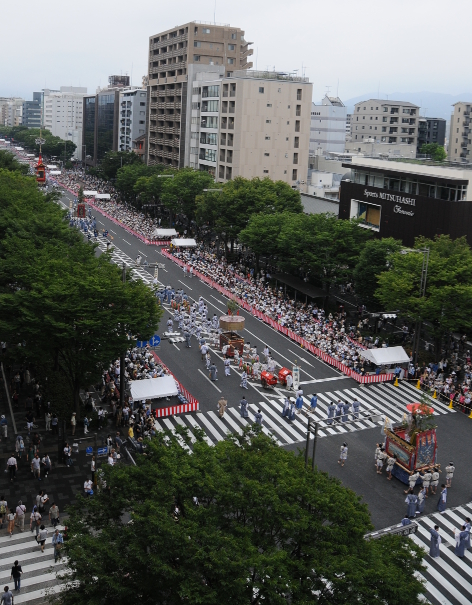Yesterday, there was a talk about “Kyoto’s festivals and events in October” to which I was invited. At first, I was reluctant to go – this is complex stuff with advanced vocabulary – but it turned out alright, thanks to the many photos and a bit of background knowledge I had gathered over the years. I was able to understand the gist of the talk, and it was fun, too.
Directly afterwards was another talk, and since there was no break, I felt it was rude just to leave, so I was a bit annoyed at first that I was forced to stay. With the handout we all got at the beginning consisting mostly of text, I didn’t expect to understand anything.
However, this talk turned out to be extremely interesting. When you look at a map of Kyoto, you may notice that Oike, Horikawa and Gojo dori around the city center are significantly wider than any of the other streets in Kyoto. The reason for this is that they were artificially widened during WWII, when people were worried about air-raids and resulting large-scale fires. At the time, Kyoto still had mainly wooden buildings, especially in the old part of town in the center. So, the above mentioned streets were broadened – Oike dori from some 20 to now 50 meters – and together with Kamogawa river, they still create a rectangle around what was then the most populated part of Kyoto.

This is especially obvious at the crossing of Oike – Horikawa streets, where these two huge roads dwindle into nothing towards the north and west, in the case of Oike dori immediately behind the crossing. And on photos of Gojo dori in that area, you can clearly see that the northern side still has a number of old, wooden houses, while the southern side consists of mostly new(ish) apartment buildings. Also, according to the talk yesterday, what is now the pavement on the north side was once the entirety of Gojo street.
I had indeed noticed the abrupt ending of the broad Oike dori at Horikawa before, but never questioned the why. I mean, it’s Japan, don’t they do all sorts of weird stuff? Knowing the reason behind this makes it even more fascinating. And a bit sad too. Who knows how many ancient machiya were destroyed at the time…
Anyway, both talks were given by members of the Kyoto Historical Research Society, a loose organisation of local history buffs. Obviously, I was lucky to understand what was going on yesterday, this won’t be the case in general. However, I hope there will be more of these talks about festivals, they are fairly easy to understand, and as a bonus, help me with my job.

日本語上手ですね😏
Interesting stuff. Nice that you get invited to such things. 😳
Oh my, I just got jousu-ed. *shock*